CHOLESTYRAMINE - ORAL
PHONETIC PRONUNCIATION: (KOE-le-STYE-ra-meen)
COMMON BRAND NAME(S): Prevalite, Questran
GENERIC NAME(S): cholestyramine/aspartame
Uses
USES: Cholestyramine is used along with a proper diet to lower cholesterol in the blood. Lowering cholesterol helps decrease the risk for strokes and heart attacks. In addition to a proper diet (such as a low-cholesterol/low-fat diet), other lifestyle changes that may help this medication work better include exercising, losing weight if overweight, and stopping smoking. Consult your doctor for more details. Cholestyramine may also be used to treat itching in people with too much bile acid caused by a certain type of liver/bile duct disease (partial biliary obstruction). This medication is known as a bile acid-binding resin. It works by removing bile acid from the body. In people with high cholesterol, this causes the liver to make more bile acid by using cholesterol in the blood. This helps to lower the cholesterol levels.
How to use CHOLESTYRAMINE - ORAL
HOW TO USE: Take this medication by mouth as directed by your doctor, usually 1 to 2 times a day. This medication comes as a powder with doses measured by the scoopful (using the provided scoop) or in individual dose packets. Do not take your dose in the dry powder form. Mix the medication in at least 2 to 6 ounces (60 to 180 milliliters) of liquid (such as water, milk, fruit juice), stir completely, and drink right away. Rinse your glass with more liquid and drink the rinse liquid to be sure that you have taken the entire dose. You may also mix this medication with watery soups, applesauce, or a pulpy fruit which has a lot of juice (such as crushed pineapple, peaches). Do not hold the mixture in your mouth for long since doing so can damage your teeth. Practice good dental habits (such as brushing and flossing your teeth regularly). The dosage is based on your medical condition and response to treatment. To reduce your risk of side effects, your doctor may direct you to start this medication at a low dose and gradually increase your dose. Follow your doctor's instructions carefully. It may take several weeks before you get the full benefit of this drug. Cholestyramine may decrease your absorption of other medications. Take your other medications as directed by your doctor, usually at least 1 hour before or 4 to 6 hours after cholestyramine. Ask your doctor or pharmacist for more information or if you have any questions. Take this medication regularly in order to get the most benefit from it. To help you remember, take it at the same time(s) each day. It is important to continue taking this medication even if you feel well. Most people with high cholesterol do not feel sick.
Side Effects
Precautions
Interactions
Overdose
Images
Reviews
Faq for CHOLESTYRAMINE - ORAL
Cholestyramine is a medication used to lower cholesterol levels in the blood. It belongs to a class of drugs known as bile acid sequestrants.
Cholestyramine works by binding to bile acids in the intestines, preventing their absorption into the body. This leads to an increased excretion of cholesterol from the body, helping to lower blood cholesterol levels.
Cholestyramine is used to treat high levels of cholesterol in the blood, particularly low-density lipoprotein (LDL) cholesterol. It is often prescribed in conjunction with lifestyle changes, such as diet and exercise.
Cholestyramine comes in a powdered form that needs to be mixed with water or other liquids. It should be taken orally one to six times daily, depending on the prescribed dosage. It is important to follow the instructions provided by your doctor or pharmacist.
Common side effects of cholestyramine may include constipation, bloating, gas, heartburn, nausea, or stomach pain. These side effects are usually mild and temporary. If they persist or worsen, you should contact your doctor.
Yes, cholestyramine may interact with certain medications. It can reduce the absorption or effectiveness of other drugs taken at the same time. It is important to inform your doctor or pharmacist about all the medications you are currently taking before starting cholestyramine.
Cholestyramine should not be used by individuals with complete biliary obstruction or known hypersensitivity to the drug. It may also interfere with the absorption of fat-soluble vitamins, so supplementation may be necessary. It is important to discuss any existing medical conditions or allergies with your doctor before taking cholestyramine.
The full effects of cholestyramine may not be seen for several weeks. It is important to continue taking the medication as prescribed, even if you do not notice immediate results.
The safety of cholestyramine during pregnancy or breastfeeding has not been established. It is important to consult with your healthcare provider before using this medication if you are pregnant or breastfeeding.
Disclaimer
IMPORTANT: HOW TO USE THIS INFORMATION: This is a summary and does NOT have all possible information about this product. This information does not assure that this product is safe, effective, or appropriate for you. This information is not individual medical advice and does not substitute for the advice of your health care professional. Always ask your health care professional for complete information about this product and your specific health needs.

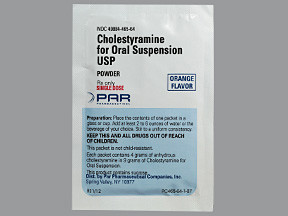
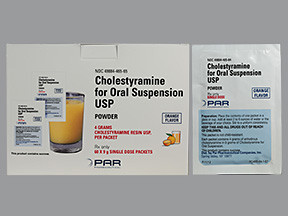


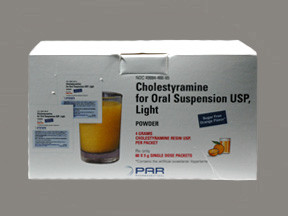
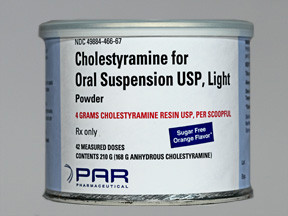
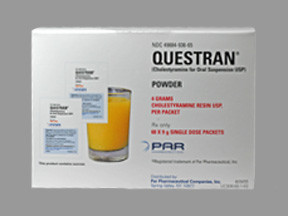
No Reviews Yet